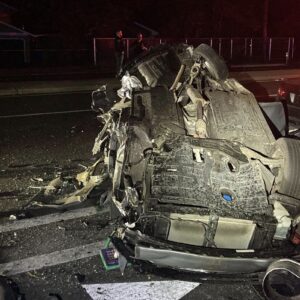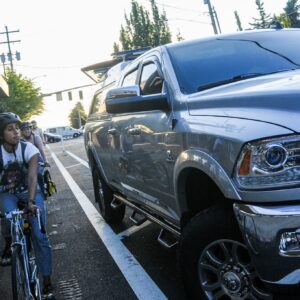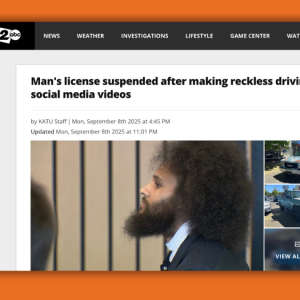Distracted driving is arguably the most important traffic safety issue facing America today. Amazingly, while we have many advocates and other smart people working to address the issue, the auto industry seems to be promoting it by turning cars into rolling computers.
A few things came across my desk this morning that show how these two trends — getting tough on distracted driving on one hand, while promoting it on the other — continue to be at odds with each other.
US DOT Secretary Ray LaHood released the latest piece in his ongoing series, Faces of Distracted Driving. As a father and as someone who likes to ride bikes on occasion, this one really struck a nerve with me. It features the story of 19-year old Eric Okerblom who was killed in 2009 after being struck by a man operating a truck at 60 mph while simultaneously texting on his phone…
As we’ve covered distracted driving over the years, people have often suggested that smart phones that would automatically turn off while a car is in operation would be a great solution to the problem. This morning I was happy to read a post on The Infrastructurist that reviewed several such apps. Turns out that Sprint introduced an app (aptly) called “Drive First” that’s set to come out later this year.
While I’m happy to see these apps and LaHood’s continued focus on this issue, my good feelings were hampered by news from the auto industry’s latest arms race. Here’s a snip from a disturbing Yahoo News story:
“Analysts say consumers are warming to the notion of more connectivity in their cars, with “apps” for information and entertainment just as they have with their smartphones or tablet computers.
“Initially, putting Internet access in the car sounds like a distraction and frivolous but as time passes it will become a part of our lives and we will feel uncomfortable not having access,” said Jeff Kagan, an independent telecoms analyst.
“I think this is going to grow into a vibrant sector.””
Seems to me LaHood’s efforts and trends in the auto industry are heading in directly opposite directions. As America’s traffic safety watchdog, LaHood is in a great position to use his commitment to road safety as leverage on both telecoms and the auto industry.
President Obama is currently contemplating a mega-merger between AT&T and T-Mobile. While I’d rather not see that merger happen at all, perhaps LaHood can use the potential deal as an opportunity for leverage; as in, if they merge, the companies must agree to major funding of distracted driving prevention efforts. On a similar note, perhaps LaHood and Obama could use their bailout of the auto industry as leverage to reign in the cars-as-rolling-smartphones trend.
With powerful lobbies, getting anything out of telecoms and the auto industry wouldn’t be easy; but distracted driving is quickly becoming an “epidemic” (in LaHood’s own words), and left to their own devices, I’m afraid corporations might get distracted by profits.
— Jonathan Maus, (503) 706-8804 – jonathan@bikeportland.org
BikePortland can’t survive without subscribers. It’s just $10 per month and you can sign up in a few minutes.







Thanks for reading.
BikePortland has served this community with independent community journalism since 2005. We rely on subscriptions from readers like you to survive. Your financial support is vital in keeping this valuable resource alive and well.
Please subscribe today to strengthen and expand our work.
I very simple fix to the computer consoles in automobiles to allow them to exist without contributing to distracted driving would be to program them so that they cannot be adjusted while the car is in motion.
Unfortunately, I think that there is very little that can be done about the increase of technology integration into cars. Most Americans choose lifestyles that lead to long commutes alone by car, and are willing to pay to make this wasted time more useful. The best thing we can do is to make the issue more visible, as you are doing here, and to set an example for others, showing them how they can live differently. Living in areas with shorter commutes, and options for different modes (cycling, public transit).
I hope that the carnage induced by this technology will stay on the interstates, but I know that won’t be true.
We could replace the most flawed component of motor vehicles (the driver) with a computer and then the passengers can do whatever they damn well please. I don’t know why there isn’t more demand for this among those who have regular long commutes. Just imagine if you could sit back, enjoy coffee and breakfast and maybe post a few comments on the Internet, all while your car drives you to work.
No more speeding. No more ‘accidents’. No more congestion. No more need for cars that are engineered to exceed the needs of public driving. No more tire dealers trying to up-sell you on the tires that are rated upto 130 mph…as if I should expect the exceed the 110mph rating of the cheaper tires.
Even with computer aided driving, you’d still have congestion if everyone was in a single-occupant vehicle. It just isn’t feasible to continue this path.
Though I agree that the sheer number of single-occupancy vehicles is silly and wasteful, I disagree that computer aided driving couldn’t resolve congestion.
Networked vehicles would not have difficulty merging, would not require stop lights and other external traffic control, and would not be as prone to accidents that cause major back ups. Further more, such smart vehicles would not get lost, make wrong turns, search for parking, etc.
Congestion, especially on larger highways is not just a result of lots of traffic. It also requires lots of people to drive in less than an optimal fashion, something which people excel at.
Hopefully they’ll also be less prone to drifting over fog lines. I had a Honda Pilot’s mirror literally graze my arm yesterday; had just been thinking what is that hot air blowing on my leg (it was from her engine; and she wasn’t even yacking on the phone).
Doesn’t public transportation encompass 95% of that?
…And no new tires needed.
I’m not talking about giving people a choice to have an automated car. I’m saying that should be the only option…if you want to own a car at all.
Public transportation, as is currently available, doesn’t meet a primary requirement of transportation for many people: door-to-door service.
Mass transit is famously capable of generating its own unique form of congestion, as exemplified by commuter hour on trains in Japan.
Interesting idea. It could allow freeways to function far more effectively. Imagine people queuing on the freeway approach and being assigned a digital numerical time for access to the freeway. Nobody gets to tailgate…nobody gets to lane hop if they aren’t maneuvering to exit, or follow a pre-trip designated route (see…right there’s a hitch, if someone had to change destination in the middle of the trip.).
It could be rigged up so that if a required number of people weren’t in the car, they wouldn’t be granted access to the freeway approach.
Very good suggestion, there is a great deal of R&D going on in that realm, and I suspect it’s another reason Google goes through the expense of mapping the world’s roadways. They’re likely banking on the future value of that information, not just the present.
My company does a great deal of work in “In-Vehicle Infotainment”… I definitely echo the majority of sentiment here (risking my life to distracted drivers), but there is also a great deal of research into making IVI less distracting. Technology companies are looking for differentiators in the IVI market (as are car companies), and that’s a bigger one than this article seems to give it credit for.
Any of you use Google voice? Chuckle at the humorous transcriptions of your messages and then check the box saying “may we use your message to improve our recognition technology?”? I would much rather talk to my car’s computer than look at it. I suspect Google knows this value as well.
Another point… don’t be surprised if many of the engineers and product managers designing IVI systems understand things from the cyclist’s perspective. I ride with some of them daily.
(No, I don’t work for Google, BTW)
so, it seems that driving is boring and stressful? perhaps we just need more roads like this, and a couple spare planets to keep them free of traffic: http://www.flickr.com/photos/robsentz/4620177736/ . until then, maybe they could project images of roads like this, heads-up, onto the windshields. failing that, maybe make driving more stimulating by relaxing the crash-test, airbag and seatbelt requirements, while cutting vehicular weight to maybe 800lbs average, such that speeds above 30mph are much more thrilling, what with the shaking and effects of crosswinds and so on. 100mpg would be easy, too!
I think you will soon start to see motor vehicle manufacturers named as co-defendants when people are killed by other people who are using these devices. These companies know that they are enabling distracted driving by putting these amenities in vehicles. And they should pay the costs of profiting from this instead of the victims.
You seem to make the assumption car makers are putting IVI systems into cars in order to distract drivers. Of course they’ll inherit that liability (as the insurance industry mainly will – the lobby, incidentally, that is still the largest force of change on automotive manufacturers). Why would they want to increase it?
Not saying it’s not going to happen, but some people have the perception of the “network in the car” akin to being able to surf eBay for bike frames or comment on bikeportland while they’re driving down the road. (OK, yeah, those are my use cases ;). The Internet is more than just a browser though.
From Jeffkagan.com
“Kagan follows the healthcare, wireless and telecom industry and how they are crashing together”
Or, sic transit gorier
Heh.
But seriously, it’s almost as though we are experiencing the auto revolution all over again. The first time resulted in a bunch of restrictions and new laws and control devices to regulate the use of these new machines called “automobiles” and minimize the killing and injuring of others. This time around, however, lawmakers seem focused on creating ways to blame victims of motor violence to make it easier for car companies to sell stuff like this since drivers won’t be held accountable for the damage they cause while distracted by gadgetry in their vehicles. The next person who claims bikes are toys…
When was the last time anyone can remember a significant merger quashed by the SEC? Anybody?
I dont think the SEC can quash mergers. You are thinking of the DOJ. Yes they dont seem to fight mergers very hard these days, but hopefully they will block this one.
Bill Gates wanted the internet in cars a long time ago. Imagine that. MS software to boot ( er, I mean reboot?).
brings new meaning to the terms “crash” and “blue screen of death”
Not funny, yet hilarious.
I actually think more tech in the car could be a good thing if it advances to the point where it won’t be such a distraction, like the Ford Sync system that allows you to hear texts and send them with voice activation.
There is no way the government will ever be able to pass something to turn off people’s phones in their cars! People freaked out when they tried to give them healthcare, do you think they’re going to let the gubment take away their “freedom” to play with their toys while performing their God given “right” to drive?
This one hits close to home! I am currently consulting with a large auto manufacturer, working on the technologies that you mention above, known in the industry as IVI, “In-Vehicle Infotainment”. Some of the stuff that is being talked about is innocuous while some creates new possibilities of distracted driving while others will drastically increase safety. For example, imagine an automobile with GPS and extensive map information such as where predestrian crossing, bike crossings, bike lanes, etc are along with speed limits all being used to a) limit vehicle speed, b) warn the driver, c) automatically make adjustments to car behavior (for example, automatically widening the reach of headlights as a car approaches an intersection or pedestrian crossing). In my opinion these are all technologies that can reduce the number of deaths and at least here in Europe where I’m currently working, the auto manufacturers take safety requirements very seriously and there is a lot of pressure from governments to help drivers be less distracted and the “entertainment” parts of the systems are designed so that they cannot be used at all times or by all users (for example, the video play back and streaming “app” can only be used by a backseat screen, not the front center console that the driver uses.)
As Chris said in the comment at the start of this article, the integration of technologies into the automobile is inevitable. “Consumers” are used to being connected everywhere they go and the auto industry and the consumer electronics industry are looking for new markets. What we need to do is put pressure to have regulations that ensure that the safety is always #1.
I also agree with Jack that automation is the way to go and I honestly believe that the technologies currently being developed are going to lead to that. Roads and signs and cars and street lights will all be integrated into one big autonomous self-regulating network. I think in this world, separate bike facilities will be a must.
I hope I don’t come off as a marketing person for the car industry. It has been quite challenging to be working on something that I’m not really sure we need (and amusing at times too…I haven’t owned a car in 5 years and am telling them what features may make sense in a car computer system), but has also been a great opportunity to gain some perspective how the automobile industry works and where it is headed. In doing this, I’ve realized that being aware of and involved with transportation issues requires keeping an eye on that industry as it has much more influence than the bike or transit-oriented industries and lobbies. If we don’t watch what they are doing so we have time to react, we’ll be side swiped by what’s to come.
I share your perspective. Nice resume, too, by the way. Let me know if your new company isn’t treating you right… 🙂
I have mixed feelings about “safety technology”: on one hand, for the conscious (and conscientious) driver, all the advancements you mention can be great things; on the other hand, the “I drove through a fence into this open field because the GPS told me to turn” crowd becomes ever scarier the more their car purports to think for them.
Don’t be surprised if that open field is already being worked by a piece of GPS-enabled autonomous farm equipment, by the way.
–Deepak Saxena
Why would separate bike facilities be a “must”? Because bikes will never ride themselves, and will therefore not be subject to the regulation of the automated network? Will automated cars not be able to “see” a bicyclist or pedestrian in the street? Would the presence of a bicycle somehow interfere with the “self-regulation” of the network?
If separate facilities would truly be a “must”, then the future of cycling is grim indeed. Since priority will never be given to “separate facilities”, any new “self-regulating” infrastructure that makes separate facilities a “must” will only serve to wipe bicycles from the roadway.